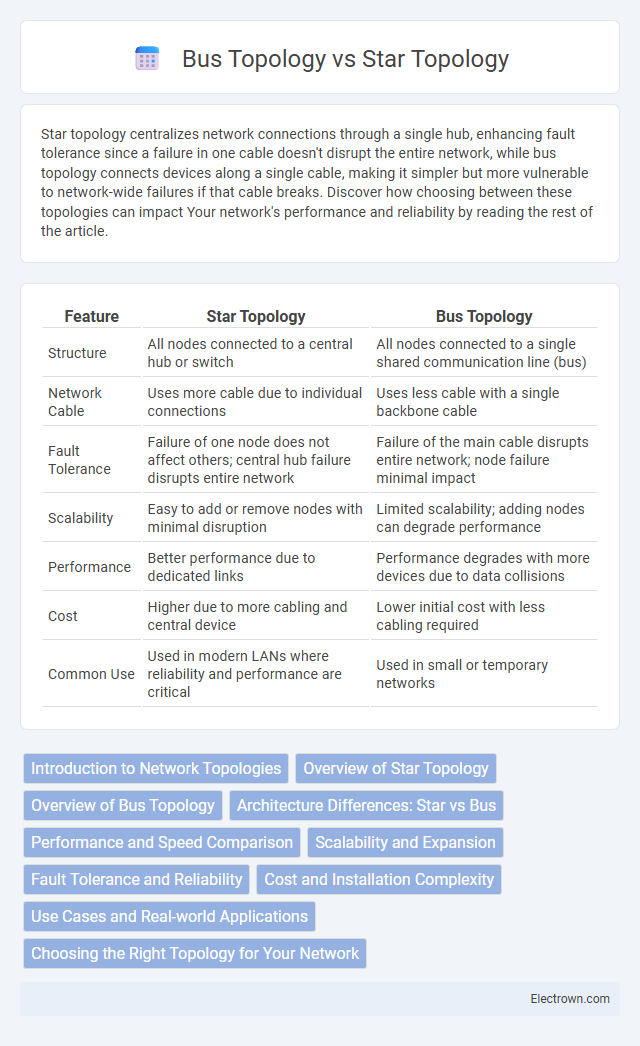Star topology centralizes network connections through a single hub, enhancing fault tolerance since a failure in one cable doesn't disrupt the entire network, while bus topology connects devices along a single cable, making it simpler but more vulnerable to network-wide failures if that cable breaks. Discover how choosing between these topologies can impact Your network's performance and reliability by reading the rest of the article.
Table of Comparison
| Feature | Star Topology | Bus Topology |
|---|---|---|
| Structure | All nodes connected to a central hub or switch | All nodes connected to a single shared communication line (bus) |
| Network Cable | Uses more cable due to individual connections | Uses less cable with a single backbone cable |
| Fault Tolerance | Failure of one node does not affect others; central hub failure disrupts entire network | Failure of the main cable disrupts entire network; node failure minimal impact |
| Scalability | Easy to add or remove nodes with minimal disruption | Limited scalability; adding nodes can degrade performance |
| Performance | Better performance due to dedicated links | Performance degrades with more devices due to data collisions |
| Cost | Higher due to more cabling and central device | Lower initial cost with less cabling required |
| Common Use | Used in modern LANs where reliability and performance are critical | Used in small or temporary networks |
Introduction to Network Topologies
Star topology features a central hub connecting all devices, enhancing fault isolation and simplifying troubleshooting compared to bus topology, which uses a single shared communication line. Bus topology's linear structure reduces cabling costs but faces challenges with collision domains and network scalability. Network efficiency and reliability often improve with star topology due to dedicated point-to-point connections between devices and the central hub.
Overview of Star Topology
Star topology features a central hub or switch that connects all devices individually, enhancing fault isolation and network management efficiency. This configuration allows easy addition or removal of nodes without disrupting the entire network, making it highly scalable and reliable. Your network benefits from improved performance and simplified troubleshooting compared to bus topology, which relies on a single communication line.
Overview of Bus Topology
Bus topology connects all devices through a single central cable called the bus or backbone, allowing data to travel in one direction to each device. This configuration offers simplicity and lower cost for small networks but suffers from performance issues and data collisions as the network grows. Your network's efficiency in a bus topology can be hindered by any cable failure, which can disrupt communication for all connected devices.
Architecture Differences: Star vs Bus
Star topology features a centralized hub or switch that connects all devices individually, ensuring easy fault isolation and consistent performance. Bus topology uses a single shared communication line where all devices are connected sequentially, which can cause data collisions and is harder to troubleshoot. Your choice between these architectures impacts network scalability, reliability, and maintenance efficiency.
Performance and Speed Comparison
Star topology offers higher performance and faster data transfer due to dedicated point-to-point connections between devices and the central hub, minimizing data collisions and congestion. Bus topology experiences slower speeds as all devices share a single communication line, leading to data collisions and retransmissions that degrade performance. Network efficiency in star configurations remains stable under heavy traffic, whereas bus topologies suffer significant speed drops as more devices communicate simultaneously.
Scalability and Expansion
Star topology offers superior scalability compared to bus topology, allowing you to easily add or remove devices without disrupting the entire network. Each device in a star network connects independently to a central hub, enabling straightforward expansion and minimizing performance bottlenecks. In contrast, bus topology faces limitations as adding more devices can cause signal degradation and increased collisions, hindering seamless network growth.
Fault Tolerance and Reliability
Star topology offers superior fault tolerance and reliability because each device connects independently to a central hub, preventing a single node failure from disrupting the entire network. In contrast, bus topology relies on a single communication line; if the main cable fails, the whole network goes down, significantly reducing reliability. Your choice between the two should consider the criticality of maintaining network uptime and ease of fault isolation.
Cost and Installation Complexity
Star topology generally incurs higher costs due to the need for more cabling and network devices like switches, but installation is straightforward with easier troubleshooting and maintenance. Bus topology is cost-effective with minimal cabling requirements and simple installation, but it can become complex to manage as more devices are added, increasing the risk of network failure. The choice between star and bus topologies depends on budget constraints and the desired scalability of the network infrastructure.
Use Cases and Real-world Applications
Star topology excels in environments demanding high reliability and easy fault isolation, such as corporate offices and data centers where each device connects independently to a central hub, minimizing downtime. Bus topology suits smaller networks with limited devices, often found in early local area networks (LANs) and temporary setups, offering cost-effectiveness and simple installation. Real-world applications of star topology include modern Ethernet networks due to scalability and robustness, while bus topology remains relevant in legacy systems and small-scale industrial control networks.
Choosing the Right Topology for Your Network
Star topology offers superior fault isolation and easier troubleshooting by connecting all devices to a central hub, making it ideal for networks requiring high reliability and scalability. Bus topology is more cost-effective and simpler to implement in small, linear networks but suffers from limited bandwidth and challenging fault detection. Selecting the right topology depends on network size, budget, performance requirements, and future scalability needs.
Star Topology vs Bus Topology Infographic

 electrown.com
electrown.com